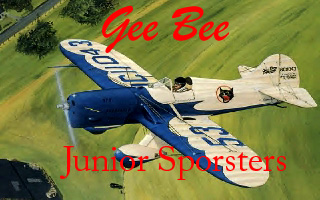

Complete drawings were made for the aircraft and it was decided to try for an Approved Type Flight Certificate. Advertising brochures were printed and sent out which claimed the Gee bee Sportster as,"The fastest and most maneuverable licensed airplane for its horsepower in the United States".
The first Two customers to order the new Sportster's, were Harold Moon and George Rand, both members of the Harvard Flying Club at Boston.
It took a great
deal of communication between the Granvilles, Bob Hall, and Mr. Moon with
the Department of Commerce for it to be granted a restricted license, and
thus the license NR 854Y. By 1-22-31, the engine had already had a top
overhaul. For "one dollar and other valuable considerations", Mr. Moon sold
the Model B on 11-15-32 to Edith J. Bernson who had the Cirrus Ensign upgraded to 125 HP. With the engine
upgrade, the fuel capacity was reduced to 30 1/2 US gallons due to weight
considerations. The Model B still carried a restricted license, and was
restricted to exhibition flights at Muller Field, Revere, Mass. On the
Dept. of Commerce Operation Inspection Report dated 5-20-33, NR 845Y was
reported to have only 150 hours total flight time. The next Operation
Inspection Report dated 6-3-33 reports a total flight time of 152 hours.
Ms. Bernson reported her change of address on 10-2-34. There are no further US records on the Model B, and it is
reported to have been sold out of the country to a party in Spain.. The Model B when sold originally to Harold Moon was painted dark brown and tan separated by a deep red 1/2 inch stripe which were copied from
the a 1930 Packard.
Both Moons Model B and Rands Model C were equipped with a new shock absorbing landing gear system which was the main improvement over the model X.
For the Model C to have become a legitimate Model D, it would have had to
have a 125 HP Menasco C4, the large fin and rudder, the full wheel pants and
streamlines, and especially would have had to have been inspected and found
to comply with the certification package which was submitted for ATC 404
approval (i.e. including drawings, engineering stress reports, etc.). None
of this is in the Model C, NC 855Y records . . . however, all of the data is
in the Model D, NC 11043 records. The only documented change made to the
Model C was to increase the fin and rudder area to improve longitudinal
stability to satisfy the DOC that a NC license could be granted on a one
time basis.
Only one Model D was built.
The improvements were a fully faired landing gear and a larger vertical fin and rudder, this aircraft was serial number D-1,NC 11043 As ATC 404 was cancelled after the Granvilles went out of business, no other
Model Ds can ever be built under it. Thus, there was only one Model D, was certificated under the original ATC 404.
Any other Model Ds built will either have to be built under another FAA
approved ATC to be certificated, or will have to be licensed as experimental. Only small bits of the original Model D, NC
11043 remain today.The owner says:"In time, history will fly again, and the Model D. NC
11043 will be resurected to once again take its proper place . . . in the
air."
The B,C,D and E Models were Sporty little aircraft,they were very fast and frequently shown off at airshows by their owners and attracted attention every where they appeared.
Note her trim streamline beauty. Admire her sturdy safe construction. Here's the airplane you would love to own. Ideally adaptable for sport,
speed, business or pleasure. Consider the many exclusive features of the
new Gee Bee Sportster. The careful engineering and workmanship which
make it so fast and safe. Note its extremely low price for such a
beautifully built airplane. Here is the speed ship that will give you
the greatest thrill in flying. Overcoming all sorts of hardships in the long dangerous grind over
mountains and deserts of the west, pilot Lowell R. Bayles of
Springfield, Mass. brought in his stock Gee Bee Sportster to win second
place in this national classic. The Gee Bee Sportster was the first
stock ship to finish. The great victory of the Gee Bee Sportster over 18 famous ships and
famous pilots is the best recommendation for the many unusual
characteristics of speed and endurance described within this folder. (There are photos of a Model D built under ATC 404 and a Model E built
under ATC 398)
ENGINE INSTALLATION The Menasco Pirate C-4, 125 hp or Warner 110 hp or Fairchild 6-390 130
hp or Cirrus Hi-Drive 95 hp engines are used in all stock Gee Bee
Sportsters. Other engines will be furnished on special order. Engine
mounts built especially stiff, reducing vibration to a minimum.
WINGS With an aspect ratio of 6.9 the wings of the Sportsters are tapered to
such a degree as to give unheard of maneuverability. The structure is
built to withstand the strain of any known maneuver. Rate of climb in
inverted flight is nearly equal to that of normal flight. Load factors
of 6 inverted and 8.6 in normal flight are maintained throughout with
wide margin of safety at all highly stressed points. WING PANELS Spars and ribs are made from carefully selected Sitka spruce. Dural compression tubes impart great torsional stiffness. Note the design and strikingly rugged appearance. LANDING GEAR Hydraulic shock struts with six-inch Oleo travel and rubber for
taxiing, combined with full air wheels, size 20 x 9 or 650 x 10 make the
roughest fields easily navigable. The whole landing structure is
enclosed in streamlined "pants" reducing drag to a minimum. Brakes optional $100 extra. GASOLINE FUEL LINE The gasoline is carried in two wing tanks and one cowl tank, the
contents of the wings being pumped by a hand wobble pump to the cowl
tank where it is fed to the motor by gravity. A special line and jet is
installed to supply fuel to the engine automatically when upside down. CONTROLS All controls are extremely light and are effective far below stalling
speeds. The load on the stick is extremely light in any maneuver. Comfortable rudder pedals of the hanging type. All control bearings are oversize with many ball bearings to prevent wear. Push pull tubes and straight cables eliminate pulleys. FUSELAGE The fuselage construction is of welded chrome-molybdenum steel tubing
throughout, making the structure extremely compact, light and rigid.
There are no welds in tension members. A detachable motor mount allows
use of any inverted, inline or radial engines. EQUIPMENT An inverted jet is built into carburetor with gravity feed from either
wing tank. A wobble pump brings the gas from wing tank to fuselage tank. A baggage compartment of 2 cubic feet capacity and pockets for logs and
maps add great comfort and unusual storage facilities for such a small
plane. The inside of the cockpit is attractively upholstered. A hand
starter can be installed if desired INSTRUMENTS The instrument board is of burled dural with a complete set of
Consolidated instruments including an air speed indicator, bank
indicator, compass, altimeter, tachometer, oil pressure and temperature
gauges, switch, choke, altitude control and booster. A turn and bank and
rate of climb indicator may be installed on the same instrument board at additional cost. FABRIC & FINISH The fabric is the finest grade Dartmouth-tex finished with 9 coats of Berryloid pigmented dope. Early orders allow choice of color combination. (the brochure includes a chart containing data on the different Sportster models) Span .............. 25 feet Wing area ...... 95 sq. ft. Length ....... 17 ft. 3 in. Height ............. 6 feet Fuel capacity .. 40 gallons Oil capacity .... 3 gallons Model Climb to 5000 from standing start with Price (1931) B���������� 6 minutes $4680 C���������� 6 minutes $4780 D���������� 4 minutes $4980 E��������� 4-1/2 minutes $5230 F���������� 3 Minutes 48 seconds $5580
GEE BEE Sporter Model B
The Gee Bee Sportster Model B, Serial No. X-2 had a manufacture date of 10-1-30, and was sold to Harold P. Moon
by
Zantford Granville on 10-7-30 for the amount of $4980. Mr. Moon had placed
a $1000 deposit on the airplane with Granville Brother's Aircraft at the
time it was ordered. It was equipped with a Cirrus Ensign 110 HP engine,
Serial No. 309, and a Hamilton Standard propeller, Serial No. 13271, hub no.
7020. The gross weight was 1275 lbs, and the empty weight was 875 lbs. It
had three fuel tanks with a 38 US gallon combined capacity.
Gee Bee Model "B" Harold moon's new Model "B" NR845Y "The Myodine Special"(click picture for a larger view) Gee Bee Sportster Model C
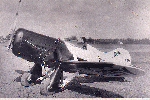
Gee Bee Model "C" (click picture for a larger view)Picture provided by Mr. David Jackson.
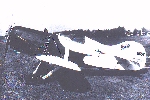
Gee Bee Model "C" (click picture for a larger view)Picture provided by Mr. David Jackson.
Gee Bee Model "D"(click picture for a larger view).
Some people speculate that Rand�s Model C was later converted to a Model D,
855Y
underwent the installation of a big fin and rudder as on the Model D, NC
11043 per Aircraft Type Certificate (ATC) 404 to satisfy the DOC to grant
the NC license to 855Y. However, according to the original DOC paperwork,
855Y never received an engine change. It was built originally with a 95 HP
Menasco B4 and crashed to its demise with the same engine.
Photos of NC
855Y after the modification do not show the wheel pants which were also part
of the certificated configuration under ATC 404. Therefore, NC 855Y was a
modified Model C, but certainly was not a Model D as defined by the ATC 404
which defines the required configuration for a Model D. There was no ATC
which covered the Models X, B, or C . . . thus the NR registrations for the
Model X and Model B, and the continued effort to satisfy the DOC
to obtain an
NC registration for 855Y.
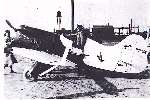 Gee Bee Model "C" with modified vertical fin and rudder.(click picture for a larger view)Pictuer provided by Mr. David Jackson.
Gee Bee Model "C" with modified vertical fin and rudder.(click picture for a larger view)Pictuer provided by Mr. David Jackson.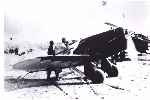 Gee Bee Model "C" with modified vertical fin and rudder.(click picture for a larger view)Pictuer provided by Mr. David Jackson.
Gee Bee Model "C" with modified vertical fin and rudder.(click picture for a larger view)Pictuer provided by Mr. David Jackson.Gee Bee Sportser Model D
One more Gee Bee in-line Sportster was built and because of various improvements that were made to get an Approved Type Certificate it was designated as Model D.
Model DSpecifications Span: 25 ft
Length: 17' 3" Engine: 95 h.p. Menasco C-4 Max Speed: 159 mph
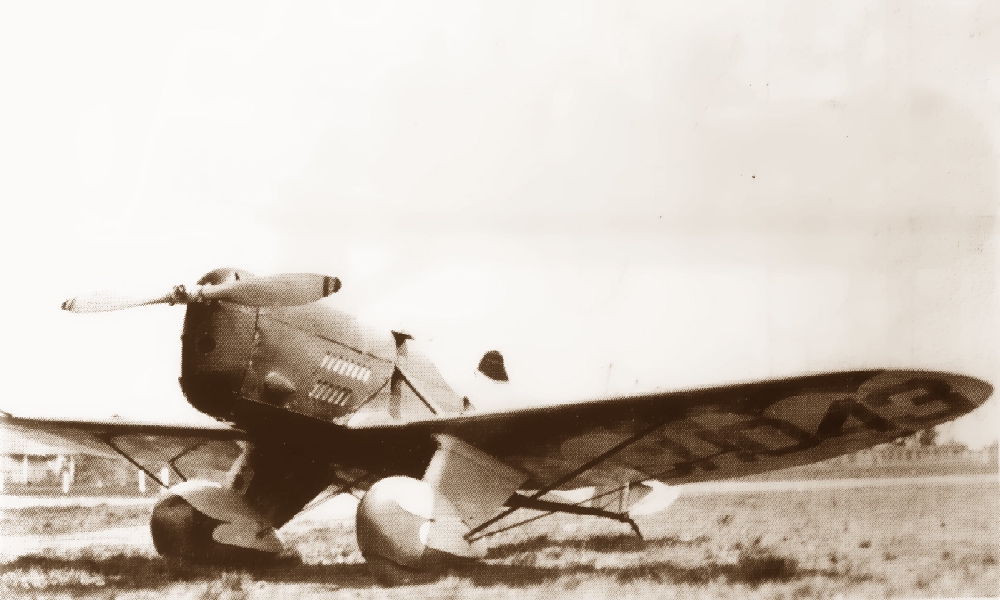 Gee Bee Model "D"(click picture for a larger view).
Gee Bee Model "D"(click picture for a larger view). R/C Gee Bee Model "D" (click picture for a larger view).
R/C Gee Bee Model "D" (click picture for a larger view).
Gee Bee Sportser Model E
As the fourth production Sportster was powered by a Warner Scarab radial engine and was designated a Model E. Later.
Model E Specifications � Span: 25 ft
� Length: 17' 3" � Engine: 110 h.p. Warner Scarab Weight: 912lb Max Speed: 148 mph
 Gee Bee Model "E"(click picture for a larger view).
Gee Bee Model "E"(click picture for a larger view). Gee Bee Model "E" Replica.(click picture for a larger view).
Gee Bee Model "E" Replica.(click picture for a larger view).
The following is a transcript of a 1931 Gee Bee Sporster Sales Brochure
I would like to thank Scott Brener for taking the time to transcribe and provide this very educational and interesting piece of historical literature.
The Gee Bee Sportster
Exerts from the 1931 Sales brochure by Z.D. Granville
Hop off in this trim little Gee Bee Sportster. Up 5000 feet in less
than five minutes. Speed along at 125 mph. Give her the gun to 150 if
you wish. Cut the gun, drop the controls - she's in a 60 mile per hour
glide. Open the throttle. Level flight again. Speed. Stability. You
never knew so much fun. You'll marvel at her maneuverability. And does
she stand up! This little ship came in second in the Great All American
Air Derby - first of all the stock planes.
Model������Motor����������H.P.������������Weight�����LandingSpeed������CruiseSpeed������TopSpeed
B�� ��Cirrus Hi-Drive����� � 95����� �� � 900��������������� 50���������������������� 120������������������ 140
C������Menasco B-4���������� 95�������������� 900������������������ 50���������������������� 120������������������ 140
D������Menasco C-4���������� 95�������������� 922������������������ 50���������������������� 130������������������ 159
E������Warner Scarab������ 110�������������� 912������������������ 50���������������������� 128������������������ 148
F������Fairchild 6-390������ 135�������������� 960������������������ 52���������������������� 135������������������ 160